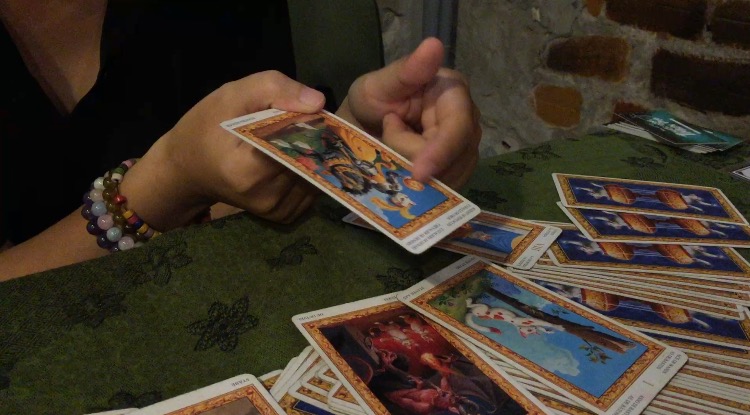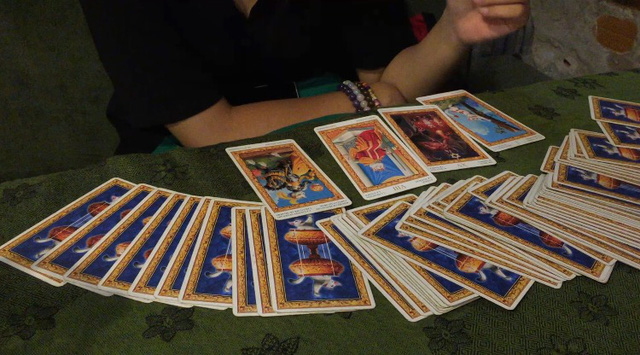Vietnamese youths seek guidance through Tarot cards
Soliciting pine counsel from picture cards is on the rise in Ho Chi Minh City
 |
A Tarot reader explains a card to the customer. Photo: Tuoi Tre
Many coffee shops in Ho Chi Minh City currently offer Tarot readings to satisfy the growing demand from young customers seeking guidance on personal issues.
At a Tarot reading coffee shop in District 10, a crowd of young people eagerly await their turn with the reader, seemingly unconcerned with their usual weekday responsibilities.
“For privacy reasons, only one customer is allowed to sit with the Tarot reader at a time. Friends have to wait outside,” a young employee explained.
The first 30 minutes of Tarot reading costs VND150,000 (US$7).
An additional VND20,000 ($1) is added to the bill for every 10 extra minutes the customer wishes to spend with the reader.
Before entering the room, customers are reminded that they may ask any question except those related to death and fortune.
The consultation then begins when the reader expertly spreads the 78-card Tarot deck into a perfect arch across the table.
Eight cards are then drawn from the deck, which the reader then interprets in order to paint a general picture of the customer’s life, work, and family.
Additional cards are drawn throughout the session to offer insight into any other questions the customer might have.
 |
78 cards are used to gain insights into a person’s past, present, and future. Photo: Tuoi Tre
“We also offer online Tarot readings through messaging apps such as Facetime, Zalo, or Viber and the customers can pay via bank transfer,” an employee said.
Training courses for aspiring Tarot readers are also offered for a ‘tuition fee’ of VND2 million ($88) for 12 lessons.
Huong Lan, 29, said she was consulting the cards to help with decisions related to a number of family issues.
“There are things that you simply can’t share with others,” Lan explained. “Talking with a Tarot reader is easier, since they don’t know who I am. It helps free my mind and make more informed decisions.”
For Ngo Quoc Cuong, a 31-year-old data analyst-turned-Tarot reader, the art is a newfound passion.
“I was immediately fascinated by Tarot during my first encounter with the cards,” Cuong said. “I taught myself [to read Tarot cards] through books and online sources. It was not until I mastered the meanings of the cards that I began doing it for money.”
Cuong now works as a full-time Tarot reader offering services for VND200,000 ($9) per session.
According to Cuong, the accuracy of Tarot readings relies largely on the customer’s cooperation and truthfulness, “like how a psychiatrist cannot help patients if they’re unwilling to share information about themselves."
“Our work is also similar to that of psychiatrists in that we help our customers relieve stress, regain balance in life, and solve personal problems,” Cuong said.
| Tarot cards have been around since the 15th century under a variety of names including Trionfi, Tarocchi, and Tarock. In many parts of Europe, Tarot cards are still used for their original purpose as game cards. Tarotology, or Cartomancy, became popular in the late 18th century as a form of pination practiced by using the cards to gain insight into the past, present, or future. A modern Tarot deck is typically composed of 78 cards with face designs varying from one deck to another, depending on the creator. Considered a pseudoscience, Tarot reading involves knowledge and understanding of the cards, as well as the reader’s own ‘clairvoyance’ to make judgments or predictions about an issue. |
VNF/TTO
Recommended
 Handbook
Handbook
Vietnam Moves Up 8 Places In World Happiness Index
 Handbook
Handbook
Travelling Vietnam Through French Artist's Children Book
 Multimedia
Multimedia
Vietnamese Turmeric Fish among Best Asian Dishes: TasteAtlas
 Handbook
Handbook
From Lost to Found: German Tourist Thanks Vietnamese Police for Returning His Bag
 Handbook
Handbook
Prediction and Resolution for the Disasters of Humanity
 Handbook
Handbook
16 French Films To Be Shown For Free During Tet Holiday In Vietnam
 Handbook
Handbook
Unique Cultural and Religious Activities to Welcome Year of the Snake
 Handbook
Handbook
